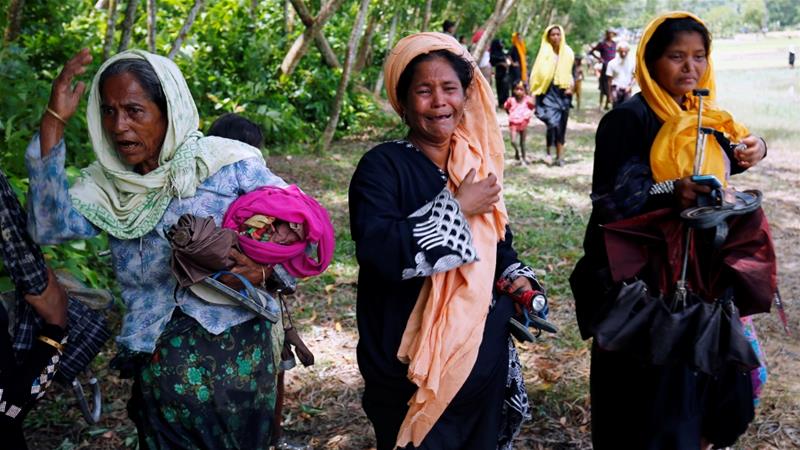HRW: Satellite data show fires burning in Rakhine state
August 29, 2017
Human Rights Watch says satellite data show fires have razed 100km of land in Rakhine state in the wake of crackdown.

Satellite data accessed by a rights body shows widespread fires burning in at least 10 areas in Myanmar’s Rakhine state, following a military crackdown on the country’s Muslim Rohingya population.
Residents and activists have have accused soldiers of shooting indiscriminately at unarmed Rohingya men, women and children and carrying out arson attacks.
However, authorities in Myanmar say close to 100 people have been killed since Friday when armed men, reportedly from the Arakan Rohingya Salvation Army (ARSA), launched a pre-dawn raid on police outposts in the restive region.
Myanmar authorities say Rohingya “extremist terrorists” have been setting the fires during fighting with government troops, while Rohingya have blamed soldiers, who have been accused of carrying out extrajudicial killings.
A government spokesperson could not be immediately reached for comment.
“The Burmese government should grant access to independent monitors to determine the sources of fires and assess allegations of human rights violations,” the Human Rights Watch (HRW) said in a statement on Tuesday.
HRW said fires have razed 100km of land – an area larger than that burned during a crackdown by the Myanmar military following attacks by Rohingya fighters in October 2016, when data from the group suggested some 1,500 buildings were destroyed.
Witness statements
The locations of the fires correlate with some witness statements and media reports describing blazes deliberately set, the group said.
“This new satellite data should cause concern and prompt action by donors and UN agencies to urge the Burmese government to reveal the extent of ongoing destruction in Rakhine State,” Phil Robertson, HRW’s deputy Asia director, said in a statement.
“Shuffling all the blame on insurgents doesn’t spare the Burmese [Myanmar] government from its international obligations to stop abuses and investigate alleged violations.”
Antonio Guterres, the UN secretary-general, “is deeply concerned at the reports of civilians being killed …,” according to a statement from spokesman Stephane Dujarric.
Guterres called on Bangladesh to step up assistance to civilians escaping the violence, noting “many of those fleeing are women and children, some of whom are wounded”.
More than 3,000 Rohingya have arrived in Bangladesh from Myanmar, where the ethnic Muslim minority faces persecution, in the past three days, the UN refugee agency UNHCR said on Monday.
Bangladesh has said there are thousands more Rohingya massed on its border with Myanmar, where it has stepped up patrols and pushed back hundreds of civilians who have tried to enter.
On Monday, Bangladesh detained and forcibly returned at least 90 Rohingya refugees back to Myanmar.
About 87,000 refugees entered Bangladesh in 2016 following the military crackdown.
Ethnic cleansing
The UN believes the army’s response may amount to ethnic cleansing, allegations denied by the government of Aung San Suu Kyi and the army.
Meanwhile, Bangladesh has proposed joint military operations with Myanmar against Rohingya fighters in Rakhine state.
At the weekend, as violence in Rakhine worsened, Bangladesh’s foreign minister summoned Myanmar’s charge’d affaires in Dhaka to express “serious concern” at the possibility of a fresh refugee influx.
There are already almost 400,000 Rohingya refugees in Bangladesh in squalid camps near its border with Myanmar.


